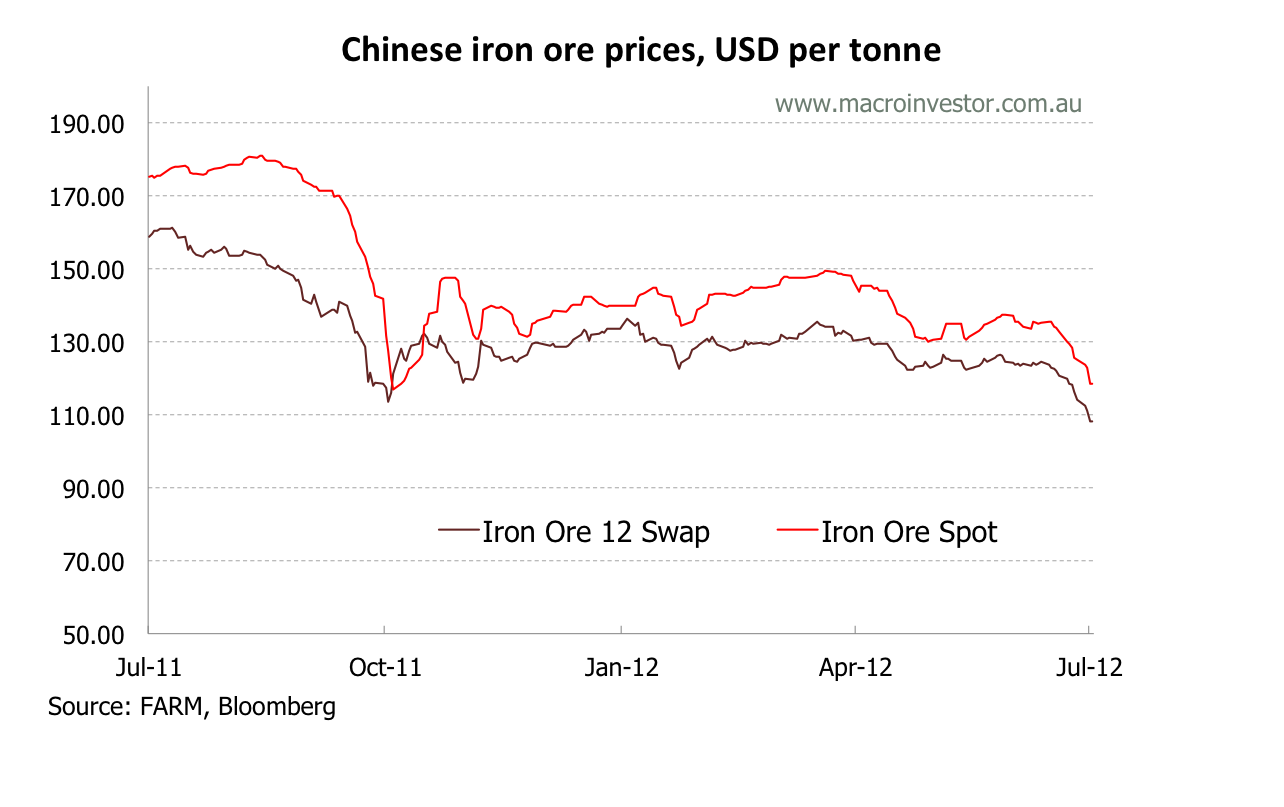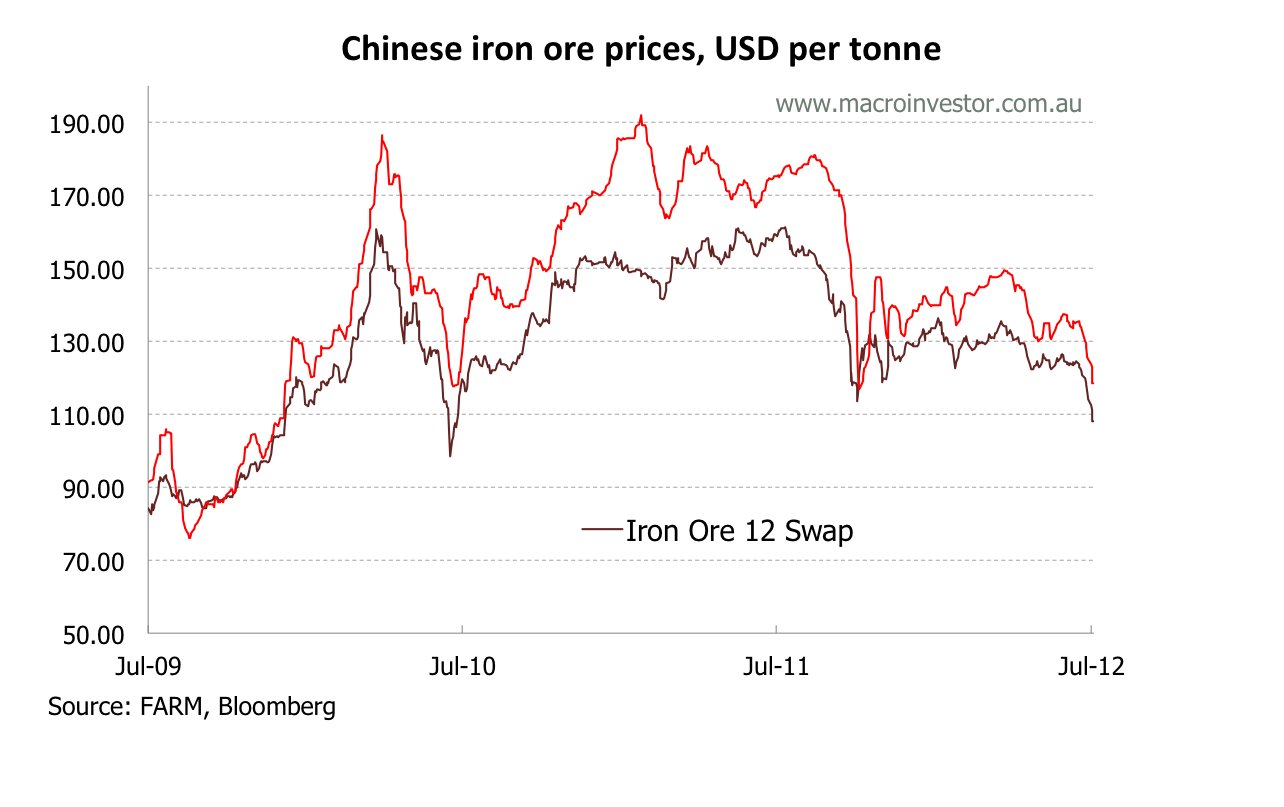By Michael Feller
Like oil, which we analysed in MacroInvestor on Monday, the iron ore market is awash with divergent indicators.
While spot and swap prices have been tracking lower in recent weeks – analysed today at length by Chris Becker and before that by David Llewellyn-Smith – many an investor has lost his or her shirt betting on ore’s demise. I know I have been as sceptical as anyone on China’s model of economic growth, but scepticism should always be tempered with an understanding that the market can remain irrational longer than you can remain solvent.
And looking at Tianjin spot and Singapore swap prices, although you can certainly see that ore’s trend has been clear over the past year, there’s been plenty of bear traps in years before.


Certainly, betting on a slowdown in China and, in particular, the fixed-asset investment (FAI) component of its economy, has been a profitable trade if you were short big Australian miners, but as valuations blend into bargains, will it be so in the future?
It’s never a good idea to pick the bottom of the cycle, but as bearishness on China’s FAI overhang and fears over the quality of FAI and local government credit heats up I can’t help thinking that things are about to turn. China, it should be remembered, still has vast reserves of captured savings and an enormous ability to use fiscal policies impossible in Western societies, even if their monetary policy choices are hampered by inflationary fears and the US Dollar peg. Thus while those legendary US Treasury reserves cannot be used, there’s plenty of Yuan in the kitty thanks to the prodigious captured savings of Mr and Mrs Zhou Average.
As I wrote in MacroInvestor several weeks ago (see China will bridge the stimulus gap), in a year when the Politburo changes hands and social tensions are arguably at a post-1989 high, Beijing’s path of least resistance is to stimulate further even if that exacerbates the very imbalances that economists such as Michael Pettis, Victor Shih, Andy Xie and Patrick Chovanec have warned about for years. Further, China’s ruling elite – the same people who are wealthiest are usually the most powerful– has its own self-preservation to consider.
After ploughing billions of Yuan into surplus infrastructure, housing and heavy industry, are China’s elite really going to allow those assets to go bust when the captured savings of China’s masses can still adequately foot the bill? And after the floods in Beijing and the droughts in provinces to the West, a lot of Chinese infrastructure – be it agricultural, environmental or drainage – is surely in need of investment anyway.
Elsewhere, there are still many provincial and local government officials who would love to build more freeways, rail tracks and skyscrapers (Chengdu is building 90!) and still have the imprimatur to do so. Indeed, the same day that Bloomberg reports a 49% fall in Chinese steel industry profits and an 18% drop in the global steel producers index, Xinhua heralds plans for a high-speed rail network that will reach almost every Chinese city with a population over 500,000 by 2015. And on the same day that our friend Zarathustra reports more signs of corporate failure, we have manifest proof that Chinese state-owned enterprises have ample cash to burn otherwise why else would Tony Abbott be on TV?
Of course you would need to believe in unicorns to take China at its word, or believe that every project will go to plan, but so far that’s been a pretty smart strategy insofar as predicting Chinese growth over the past ten years. Thus while we can scoff at the various analysts and economists who’ve been bullish to date, the joke’s been on us bears.
At Eureka Report I was of the firm conviction that a bad debt crisis would derail China’s FAI-heavy growth model and bring Australia’s miracle economy down with it. I was also of the firm conviction that amid a rolling credit crisis in Europe and America such an event would occur sooner rather than later. But while I certainly think this is still a possibility, since joining Macro Associates I’m closer to the view that China will extend and pretend for at least another twelve months before the reality of mal-investment catches up to them. If a credit crunch were to detail China it would have happened already (though as Patrick Chovanec wrote yesterday, there is a large amount of property credit falling due this year).
Additionally, there’s always an upside possibility that it will all work out and China will muddle through its transition to sustainable growth with nary a hard landing. But all the same, while China’s household sector could certainly catch up to the front-loaded FAI sector through the tightrope work of guided fiscal stimulus, that’d be maybe akin to Angela Merkel miraculously lifting Europe to sustainable growth through guided fiscal austerity.
In the meantime, as iron ore continues to tank but hope springs eternal for further stimulus, it’s time to get a little smarter with our commodities investment strategy. On Monday we’ll be sharing a pair trade that may be able to take advantage of both crisis and opportunity in China and the resources sector. We’ll also be looking at some other ways that China may impact the property and shares you own. Until then however, establishing a firm directional trade on China’s, and, ultimately, Australia’s prosperity, is only guesswork.
Michael Feller is Investment Strategist at Macro Investor, Australia’s independent investment newsletter covering stocks, trades, property and fixed interest.